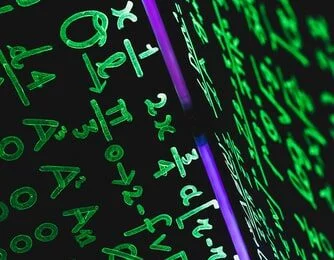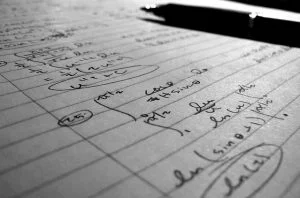This post takes a closer look at the influence of Arab mathematicians on the development of modern Mathematics.
Mathematics is considered one of the most important sciences that influenced and developed other fields such as astronomy and technology. Modern mathematics as we know it today would not have existed without the mathematicians who laid its foundations.
Among the most prominent of these mathematicians were the Arab mathematicians, who had a significant impact on the development of mathematics and its advancement to what it is today.
The Influence of Arab Mathematicians in the Abbasid Era
The golden age of Islam encompassed many advancements and progress in science in general and mathematics in particular. The 9th century CE is considered the golden age of scientific development in mathematics in the Arab and Islamic world. During this era, many Greek, Persian, and other texts were translated into Arabic, leading to a scientific renaissance in the Arab and Islamic worlds.
One of the most prominent scholars of the Abbasid era was Muhammad ibn Musa Al-Khwarizmi (780–850 AD), who authored the book Al-Jabr wa’l-Muqabala at the request of the Abbasid Caliph Al-Ma’mun. In this book, Al-Khwarizmi explained and simplified many mathematical problems to make them understandable for those interested in the subject, ensuring the book could serve as a reference for future generations. The book addressed calculations, land measurements, inheritance laws, astronomical calculations, and architectural ratios, as well as methods for working with them.

Prominent Arab Mathematicians and Their Achievements
Muhammad ibn Musa Al-Khwarizmi (780–850 AD)
Al-Khwarizmi held an important position at the House of Wisdom in Baghdad and authored numerous books that benefited those working in the field of mathematics. Among his most important works, which were translated into Greek and Latin by Western scholars, are:
- The Book of Algebra and Balancing (Al-Jabr wa’l-Muqabala)
- The Book of Arithmetic
- The Compendious Book on Calculation by Completion and Balancing
Notably, Al-Khwarizmi introduced the number zero, which was previously unknown, and introduced Indian numerals. He also created tables for finding the sine and tangent of triangle angles, which are known today as trigonometric ratios.
Additionally, he was the first to present algorithms (known as al-Khwarizmiyat in Arabic), which we still use today in technology, programming, and the internet. For this, he earned the title “Father of the Computer.”
Abu Rayhan Al-Biruni (973–1048 AD)
Al-Biruni was a traveler, philosopher, astronomer, mathematician, and geologist. He developed a theory for calculating the Earth’s radius and circumference and authored 95 books in the fields of astronomy and mathematics.
Among his most notable books in mathematics is The Extraction of Chords in a Circle by Properties of the Curved Line. He also contributed to the theory of dividing an angle into three equal parts and paid great attention to the laws of proportional sines and tangents.
Ibn Al-Haytham (965–1040 AD)
Ibn Al-Haytham is renowned for his works in optics, astronomy, and mathematics. He contributed to number theory, geometric algebra, and analytical algebra. He solved cubic equations and established precise laws for calculating the areas of solids such as pyramids, spheres, and inclined cylinders.
Omar Al-Khayyam Al-Nisaburi (1048–1131 AD)
Al-Khayyam’s most significant contributions to mathematics were in the field of algebra. He delved deeply into research on cubic and quartic equations. He also excelled in analytical geometry and geometry in general, introducing the concepts of coordinates (x and y) in mathematics. He was highly knowledgeable in the geometry of the Greek mathematician Euclid.
Thabit ibn Qurra (836–901 AD)
Modern mathematicians agree that Thabit ibn Qurra laid the groundwork for calculus by finding the body generated by the rotation of a parabola around its axis. He was proficient in many languages, which allowed him to translate numerous Greek texts into Arabic.
The Influence of Arab Mathematicians on Europe
The works of Al-Khwarizmi in particular, and Arab mathematicians in general, had a profound influence on the European Renaissance. Their books and works were translated into Latin, such as Al-Khwarizmi’s books on Indian numerals in the 12th century.
From there, these works spread to other European languages, and by the 16th century, European mathematics had advanced significantly.
Thus, the Islamic and Arab lands were a major hub for mathematics during the Middle Ages. Arab mathematicians invented many new branches of mathematics during that period, including algebra, algorithms, and arithmetic. For more than four centuries, Arab mathematicians were ahead of their European counterparts.

Arabic Mathematical Terms
Terms such as “algebra” and “algorithm,” which are still in use today, are the strongest evidence of the importance of Arab scientists’ contributions to the development of mathematics and other modern sciences based on the mathematical concepts developed by Arab and Muslim scholars.
The Arab mathematicians’ contributions formed the basis of modern mathematics, developing concepts and tools that are used in many fields, from algebra and arithmetic to computing and cryptography. These historical achievements are a reflection of the Arab culture’s lasting impact, and the influence of Arab mathematicians, not just in science and mathematics but also in arts, entertainment and broader cultural spheres, as demonstrated by famous Arab-American celebrities. This enduring legacy highlights the role of civilizations in enriching humanity and driving progress forward.
FAQ: The Influence of Arab Mathematicians on Modern Mathematics
1. How did Arab mathematicians contribute to the development of modern mathematics?
Arab mathematicians made foundational contributions to mathematics, including the development of algebra, arithmetic, and trigonometry. They translated and preserved ancient texts, added innovative ideas, and created works that significantly influenced later developments in Europe.
2. Who were some of the most notable Arab mathematicians, and what were their contributions?
- Muhammad ibn Musa Al-Khwarizmi: Known as the “Father of Algebra,” he introduced algebra, algorithms, and the concept of zero, and developed trigonometric tables.
- Abu Rayhan Al-Biruni: Advanced the calculation of the Earth’s circumference and contributed to geometric and trigonometric theories.
- Ibn Al-Haytham: Pioneered number theory, geometric algebra, and solved cubic equations.
- Omar Al-Khayyam: Made significant advancements in algebra and analytical geometry, introducing coordinate systems.
- Thabit ibn Qurra: Laid the groundwork for calculus and translated Greek mathematical texts into Arabic.
3. What was the role of the Abbasid era in advancing mathematics?
The Abbasid era (9th century CE) marked a scientific renaissance where Arab mathematicians translated Greek, Persian, and Indian texts into Arabic. This era saw the establishment of institutions like the House of Wisdom in Baghdad, where scholars like Al-Khwarizmi worked to advance mathematical theories and applications.
4. How did Arab mathematicians influence European mathematics?
The works of Arab mathematicians were translated into Latin during the 12th century and became key references during the European Renaissance. For instance, Al-Khwarizmi’s algebraic methods and Indian numeral system introduced efficient calculation methods that revolutionized European mathematics.
5. What are some Arabic mathematical terms still in use today?
Terms such as “algebra” (from al-jabr) and “algorithm” (from al-Khwarizmiyat) are derived from Arabic, underscoring the enduring legacy of Arab contributions to mathematics.
6. Why is Al-Khwarizmi referred to as the “Father of the Computer”?
Al-Khwarizmi introduced algorithms, systematic procedures for solving problems, which form the foundation of modern computing and programming.
7. How did Arab mathematicians contribute to trigonometry and geometry?
Arab mathematicians developed trigonometric tables, refined the laws of sines and tangents, and solved complex geometric problems. Figures like Al-Biruni and Ibn Al-Haytham advanced theories that remain relevant in mathematics today.
8. What was the broader cultural significance of Arab contributions to mathematics?
Arab mathematicians enriched not only mathematics but also influenced fields like astronomy, engineering, and cryptography. Their legacy reflects the profound impact of Arab culture on global scientific and intellectual progress.






